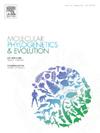Disentangling conflicting molecular phylogenetic signals in nuclear and plastid DNA of the western Eurasian-Mediterranean grass genus Cynosurus and its relatives (Poaceae subtribes Cynosurinae and Parapholiinae)
IF 3.6
1区 生物学
Q2 BIOCHEMISTRY & MOLECULAR BIOLOGY
引用次数: 0
Abstract
The western Eurasian-Mediterranean grass genus Cynosurus, comprising about 11 species, is morphologically well delimited by the regular occurrence of conspicuous sterile spikelets distal to the fertile ones on the outer, abaxial side of the inflorescences. However, our molecular phylogenetic study using nuclear ribosomal DNA (ITS, ETS) and plastid DNA sequences (trnL–F, matK) has shown that the genus is not monophyletic in its current delimitation, but consists of three distinct lineages. These lineages were found to be closely related to a group of 6–7 genera taxonomically assigned to the subtribe Parapholiinae. These Parapholiinae genera were consistently monophyletic in our analyses, but the suggested relationships to the three lineages of Cynosurus varied depending on the particular DNA region examined. This was the case for both plastid and nuclear DNA, with cytonuclear discordance and ‘chloroplast capture’ indicating earlier hybridization. Interestingly, hybridization also proved to be the most likely explanation even with regard to the 18S–26S cistrons of the nuclear ribosomal DNA, where an exceptional evolutionary divergence between ITS and ETS was found. The results highlight and illustrate the important role of hybridization in the evolution of grasses. In terms of taxonomy, our findings argue against maintaining a polyphyletic genus Cynosurus s.l. but instead argue for dividing it into three monophyletic genera: Cynosurus s.s., Falona, which is reestablished here, and Ciliochloa, which is described as a new genus. In addition, it is proposed that the two subtribes Cynosurinae and Parapholiinae be combined into a single subtribe Cynosurinae, which is also monophyletic. The possible genetic background of the formation of sterile spikelets and the occasional occurrence of inflorescences with consistently fertile spikelets are discussed. New combinations are Ciliochloa effusa, C. effusa var. obliquata, C. effusa var. fertilis, C. elegans, C. gracilis, C. turcomanica and Falona colorata.

厘清欧亚-地中海西部禾本科草属(Cynosurus)及其近缘种(Poaceae 亚种 Cynosurinae 和 Parapholiinae)核DNA 和质粒 DNA 中相互矛盾的分子系统发育信号。
西欧亚-地中海禾本科草属(Cynosurus)约有 11 个种,在花序外侧、背面的可育小穗远端经常出现明显的不育小穗,这在形态上很好地划分了该属。然而,我们利用核核糖体 DNA(ITS、ETS)和质体 DNA 序列(trnL-F、matK)进行的分子系统学研究表明,该属目前的划分不是单系的,而是由三个不同的系组成。研究发现,这些支系与在分类学上被归入 Parapholiinae 亚族的 6-7 个属密切相关。在我们的分析中,这些 Parapholiinae 属始终是单系的,但与 Cynosurus 的三个系的关系因所研究的 DNA 区域而异。质体和核 DNA 的情况都是如此,细胞核不一致和 "叶绿体捕获 "表明杂交较早。有趣的是,即使在核核糖体 DNA 的 18S-26S 三元组方面,杂交也被证明是最有可能的解释,因为在核核糖体 DNA 的 18S-26S 三元组中,ITS 和 ETS 之间存在特殊的进化差异。这些结果突出说明了杂交在禾本科植物进化过程中的重要作用。在分类学方面,我们的研究结果反对保留 Cynosurus s.l.这一多系属,而主张将其分为三个单系属:Cynosurus s.s.、Falona(在此重新确立)和 Ciliochloa(描述为一个新属)。此外,还建议将 Cynosurinae 和 Parapholiinae 两个亚族合并为单一的 Cynosurinae 亚族,该亚族也是单系的。讨论了不育小穗形成的可能遗传背景以及偶尔出现的具有持续可育小穗的花序。C. effusa var. obliquata、C. effusa var. fertilis、C. elegans、C. gracilis、C. turcomanica 和 Falona colorata。
本文章由计算机程序翻译,如有差异,请以英文原文为准。
求助全文
约1分钟内获得全文
求助全文
来源期刊
CiteScore
7.50
自引率
7.30%
发文量
249
审稿时长
7.5 months
期刊介绍:
Molecular Phylogenetics and Evolution is dedicated to bringing Darwin''s dream within grasp - to "have fairly true genealogical trees of each great kingdom of Nature." The journal provides a forum for molecular studies that advance our understanding of phylogeny and evolution, further the development of phylogenetically more accurate taxonomic classifications, and ultimately bring a unified classification for all the ramifying lines of life. Phylogeographic studies will be considered for publication if they offer EXCEPTIONAL theoretical or empirical advances.

 求助内容:
求助内容: 应助结果提醒方式:
应助结果提醒方式:


